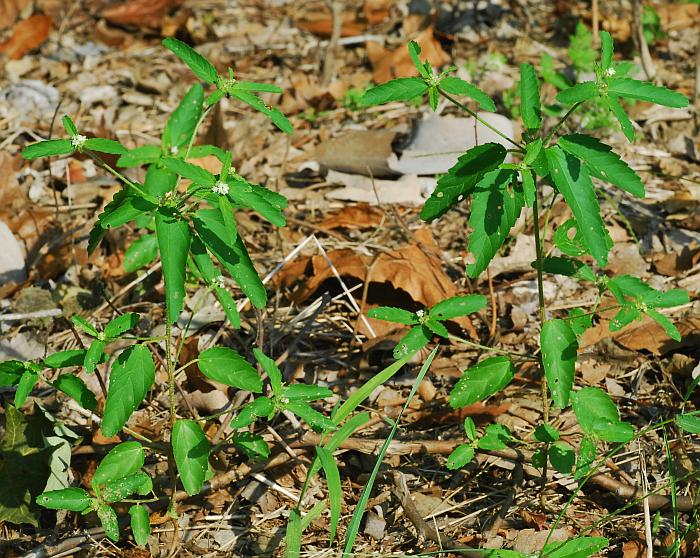Croton glandulosus L.
Sand Croton

Native
CC = 1
CW = 5
MOC = 55
© SRTurner
Croton glandulosus L.Sand Croton | |
 |
Native CC = 1 CW = 5 MOC = 55 |
© SRTurner |
|
Family - Euphorbiaceae Habit - Monoecious, annual, taprooted forb, densely pubescent with short, mostly stellate hairs, these with branches mostly 0.3-0.7 mm long and loosely appressed, but with 1 branch much longer (to 2 mm) and spreading. Sap clear. Stems - Ascending to erect, to 60 cm, usually branched, sometimes with the branches in irregular whorls, densely stellate-pubescent.
Leaves - Mostly alternate, occasionally opposite or whorled, simple, short-petiolate, stipulate. Petioles with 1 or 2 large, saucer-shaped, pale glands near the leaf blade. Blades 1-7 cm long, narrowly oblong to oblong-lanceolate, oblong-oblanceolate, or less commonly oblong-ovate, mostly angled or tapered at the base at the base, mostly angled to a bluntly pointed tip, the margins finely toothed, the undersurface sometimes slightly paler than the upper surface. Petioles and leaf undersides densely stellate-pubescent.
Inflorescence - Terminal or axillary, short, dense, spikelike racemes or clusters, with pistillate flowers toward the base and staminate flowers toward the tip. Peduncle densely stellate-pubescent. Staminate flowers subtended by a small needlelike bract to 1 mm long, with numerous glands present at the base of each pedicel. Pistillate flowers with pedicels to 0.2 mm long.
Flowers - Staminate flowers with the calyx deeply 5-lobed, 0.7-1.5 mm long; the petals 5, 1-2 mm long, white; the stamens 7-13. Filaments white, glabrous, to 1.5 mm long. Anthers pale yellow, 0.4mm broad. Pistillate flowers with calyx 1.2-1.8 mm long at flowering, becoming enlarged to 3.5-4.5 mm long at fruiting, 5-lobed, greenish, stellate-pubescent externally; the petals absent; the ovary stellate pubescent, green, superior, 3-locular, the 3 styles each deeply 2-lobed.
Fruits - Capsules 3.5-5.5 mm in length, 4-5 mm in diameter, nearly spherical, 3-seeded (rarely 2-seeded by abortion of 1 ovule), dehiscent. Seeds 3-4 mm long, oblong-ovate to oblong-elliptic in outline, somewhat flattened and often slightly wedge-shaped, the caruncle present as a small knob.
Flowering - July - October. Habitat - Glades, prairies, sand prairies, bottomland forest openings, pastures, fields, ditches, levees, railroads, roadsides, open disturbed areas. Origin - Native to the U.S. Lookalikes - None close. Other info. - This species is found throughout most of Missouri with the apparent exception of the northwestern quadrant of the state. The var. septentrionalis which occurs in Missouri has a somewhat patchy distribution, being most abundant in the lower Midwest and also in several Atlantic Coast states. The plant is recognized by its conspicuous covering of branched hairs, oblong toothed leaves, and tiny inflorescences. A diagnostic character is the presence of tiny round glands near the leaf bases; it is these glands which give rise to the species epithet glandulosus. This plant is the only species of croton in Missouri which has toothed leaves. It is most commonly found in areas of sandy substrate. Photographs taken at the Current River Conservation Area, Reynolds County, MO., 8-10-01, and in Daytona Beach, FL., 7-1-02 (DETenaglia); also near Labadie, Franklin County, MO, 9-9-2014; and along the Katy Trail near Treloar, Warren County, MO, 10-6-2020 (SRTurner). |